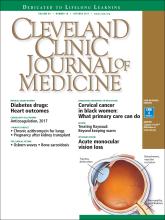Article Figures & Data
Tables
- TABLE 1
Deep vein thrombosis: 2016 recommendations of the American College of Chest Physicians
Deep vein thrombosis or pulmonary embolism without cancer For the initial 3 months, a direct oral anticoagulant (dabigatran, rivaroxaban, apixaban edoxaban) is preferable to a vitamin K antagonist (grade 2B) If a direct oral anticoagulant is not used, a vitamin K antagonist is preferable to low-molecular-weight heparin (grade 2B) Deep vein thrombosis or pulmonary embolism with cancer Low-molecular-weight heparin is preferable to a vitamin K antagonist or direct oral anticoagulant (grade 2C) Based on information in reference 1.
Preoperatively Give last warfarin dose on day –6 Start bridging on day –3 with one of the following:
Enoxaparin 1 mg/kg twice daily or 1.5 mg/kg once daily
Dalteparin 100 IU/kg twice daily or 200 IU/kg once daily
Tinzaparin 175 IU/kg once daily
Nadroparin 85 IU/kg twice dailyGive last bridging dose on the morning of day –1 Do not routinely check the international normalized ratio on the day before surgery (> 90% will be < 1.5) except for very high-risk cases or patients having neuraxial anesthesia Do not continue aspirin; stop 7 days preoperatively, and resume 7 days postoperatively Give the patient precise instructions for the bridging plan Postoperatively Give double dose of warfarin on the first 1–2 days postoperatively Resume bridging when hemostasis is secured:
24 hours after low-bleeding-risk surgery
48–72 hours after high-bleeding-risk surgeryDo not use therapeutic-dose bridging at all for:
Cardiac surgery
Intracranial or spinal surgery
Cancer surgery (eg, Whipple procedure)
Reconstructive surgery (eg, skin grafting)Direct oral anticoagulant Interruption interval Postoperative resumption Dabigatran 4–6 days 24 hours Apixaban 3–5 days 24 hours Rivaroxaban 3 days 24 hours Edoxaban 1–2 days 24 hours Based on information in reference 21.
Direct oral anticoagulant Surgery or procedure bleeding risk Low High Dabigatran (creatinine clearance ≥ 50 mL/min) 1 day off 2 days off (creatinine clearance < 50 mL/min) 2 days off 4 days off Rivaroxaban 1 day off 2 days off Apixaban 1 day off 2 days off Edoxaban 1 day off 2 days off No direct oral anticoagulant on day of surgery or procedure Based on information in reference 26.
Direct oral anticoagulant Drug half-life Renal clearance Days before surgery Apixaban 9–12 hours 25% 2 Dabigatran (creatinine clearance ≥ 50 mL/min) 12–14 hours 80% 2 (creatinine clearance < 50 mL/min) 18–24 hours 80% 4 Rivaroxaban 8–12 hours 33% 2 Edoxaban 10–14 hours 50% 2 How should acute venous thromboembolism be managed? Direct oral anticoagulants are first-line treatment, but based on a weak recommendation Low-molecular-weight heparin and warfarin are acceptable alternatives Low-molecular-weight heparin is recommended for cancer-associated venous thromboembolism Catheter-directed lysis should be considered for iliofemoral deep vein thrombosis. Use heparin bridging if the patient is taking warfarin and needs surgery? No for atrial fibrillation except for patients with CHADS2 > 4 or a recent stroke Yes for patients with a mechanical heart valve, except consideration of not bridging for a patient with a bileaflet aortic valve replacement Consider bridging for venous thromboembolism only within first 3 months of therapy. How should patients be managed if they are taking direct oral anticoagulants and need surgery? 2 days off for high risk of bleeding, 1 day off for low risk (longer for dabigatran and creatinine clearance rate < 50 mL/min) Be careful with postoperative resumption of therapy No need to bridge How should patients with a coronary stent who need surgery be managed? Wait at least 1 to 3 months after stent implantation If cannot wait, consider continuing aspirin with or without a P2Y12 inhibitor, platelet transfusion






